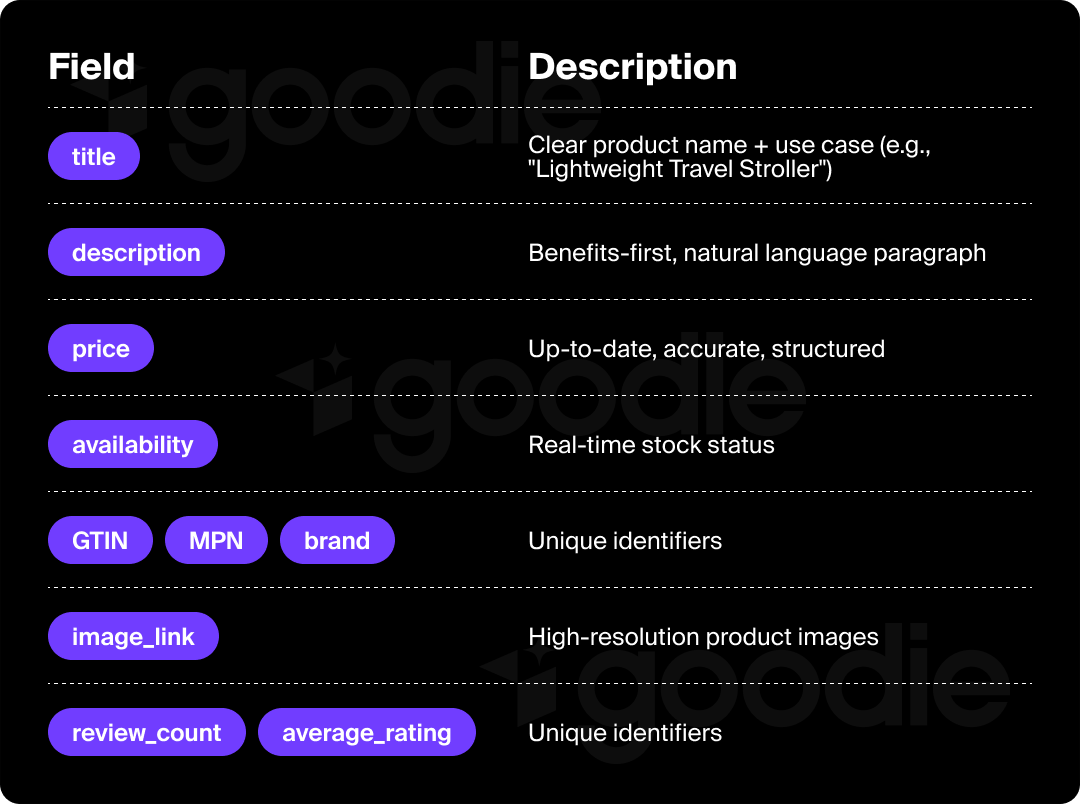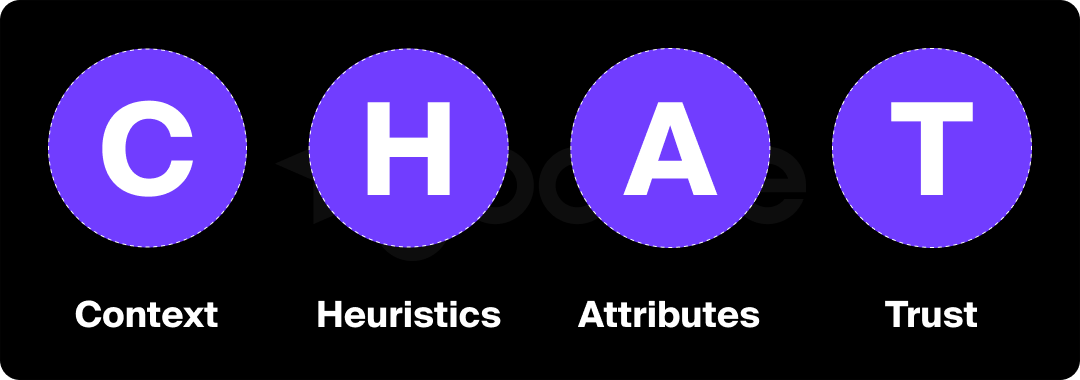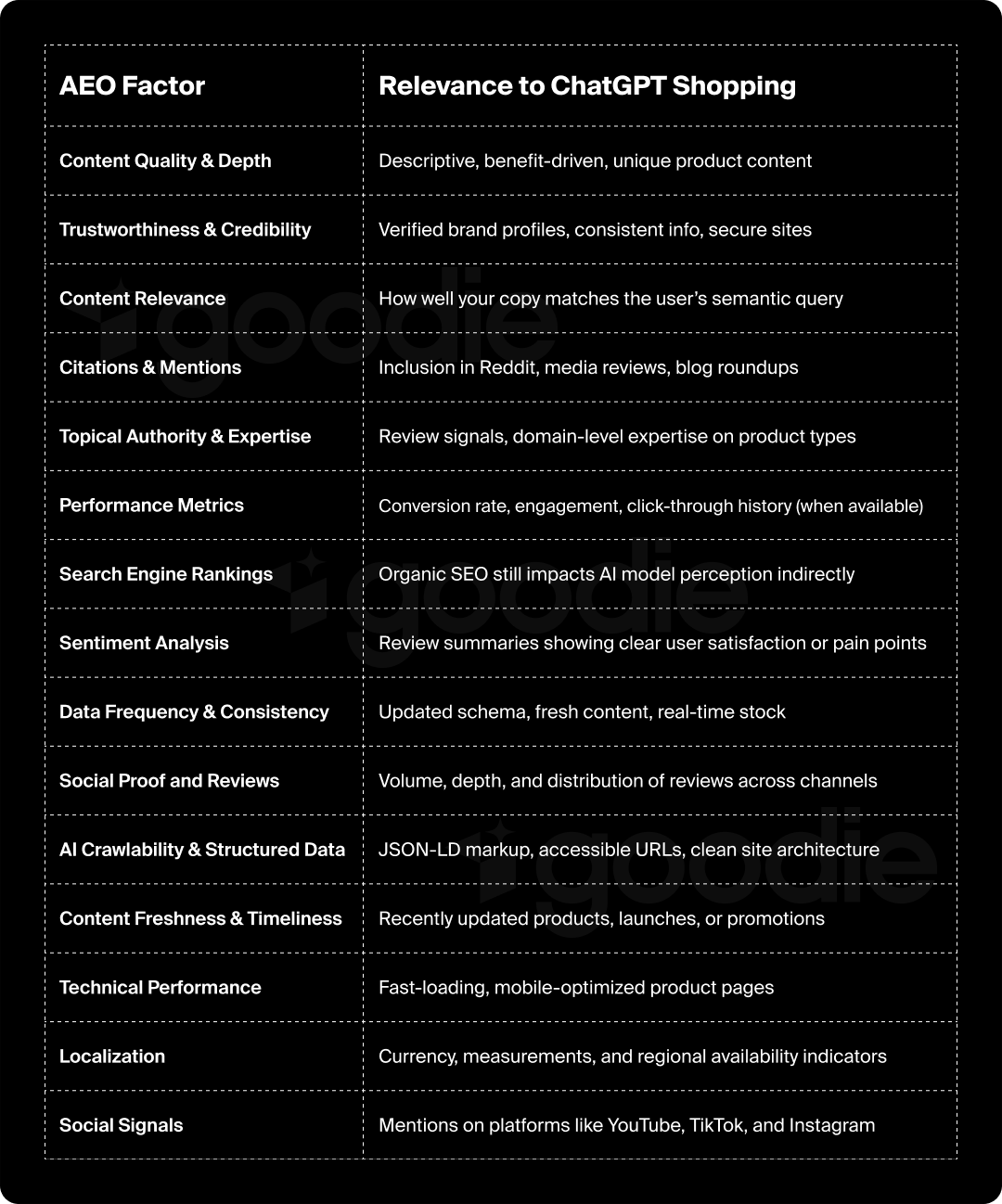AI product discovery is here and it’s changing everything in consumer search.
OpenAI’s rollout of ChatGPT Shopping marks a platform shift in eCommerce. Instead of browsing on Google or Amazon, users are now turning to LLMs like ChatGPT to get personalized, intelligent product recommendations. This guide is for consumer brands, DTC operators, and digital commerce teams ready to optimize for this new AI discovery channel.
We’ll walk through how ChatGPT Shopping works, what factors drive product visibility, and how to optimize your product data and presence for AI commerce.
Why ChatGPT Shopping Matters for Brands
The launch of ChatGPT Shopping signals a larger shift: AI answer engines are becoming the new front doors for product discovery.
When a user types something like “best dress shoes under $200” or “eco-friendly cookware set for induction stoves,” ChatGPT doesn’t send them to a list of links. It generates direct product recommendations – complete with prices, descriptions, review highlights, and merchant links – right inside the conversation.
No ads. No sponsored listings. No pay-to-play – at least for now.
Product recommendations are based on:
- User intent
- Structured metadata
- Contextual relevance
For brands, this creates an entirely new surface for visibility and performance. Think of it as a new organic channel: AI search commerce. This also means adding a new playbook.
How ChatGPT Shopping Works
When a user enters a shopping-related query like “best lightweight stroller for travel”, here’s how ChatGPT processes it:
1. Intent Analysis
ChatGPT classifies the query as shopping-focused and uses semantic understanding to categorize the user’s need (e.g., comparison, deal hunting, browsing).
2. Context is Matched
If memory is enabled, ChatGPT may use past preferences (e.g., style preferences, price sensitivity). It also incorporates instructions in the query (“under $100,” “for wide feet”) to refine results.
3. Product Data is Pulled
ChatGPT then pulls structured product data from sources like Bing Shopping, Shopify, and merchant feeds. It also gathers reviews from across the web to incorporate into results.
4. AI Generates Product Cards
Each product includes a title, AI-written summary, price, availability, review highlights, and merchant link. Labels like “Top Pick” or “Budget-Friendly” are generated by AI based on review content, not paid promotion and placements.
5. Links Are Offered to Merchant Sites
Users can click to view and buy products directly from merchants. OpenAI doesn’t take a commission or rerank listings based on commercial agreements.
ChatGPT Shopping Might Not Display for Various Reasons
The ChatGPT Shopping feature is still rolling out and might not generate for every shopping query yet. When I asked why ChatGPT shopping didn’t show up for my product query, here are the explanations I got:

What Influences Product Rankings in ChatGPT
There is no pay-for-placement model. Products show up based on:
- Trust & Safety: Products flagged for low quality or lack of social proof may be filtered out.
- Structured Metadata: Title, description, image, brand, SKU, price, availability, GTIN, size, material (the richer and more complete the data, the better).
- Review Signals: Volume and quality of user feedback; summaries are generated by AI. Products with consistent praise or clear pros/cons are prioritized.
- Intent Relevance: Semantic alignment with the query (e.g., “compact,” or “quiet”).
- Schema & Feed Quality: Incomplete or outdated metadata can cause exclusion.
5 Ways to Optimize Your Products for ChatGPT Shopping Visibility
Welcome to the world of AI Search Optimization. Here are 5 essential strategies to get your products ranked and displayed.
1. Allow ChatGPT to Crawl Your Site
Update your robots.txt file to allow OpenAI’s crawler:
User-agent: OAI-SearchBot
Disallow:Also, implement the llms.txt file to define access for LLM more broadly.
2. Structure Your Product Data Correctly
Whether you’re on Shopify, Magento, or headless, ensure your product feeds include these key attributes:

Use JSON-LD for schema markup. Validate it using Google’s Rich Results Test, but note that AI search engines may require broader attribute coverage than traditional SEO.
3. Use Conversational Copy
AI models prefer clarity. Rewriting titles and PDPs for semantic accuracy improves your chance of getting surfaced.
Examples:
- Instead of “Techwear Pants V3,” use “Waterproof Breathable Hiking Pants.”
- Add FAQ content like: “Are these pants machine-washable?” or “Do they run large?”
4. Leverage Review Sentiment
ChatGPT summarizes real user reviews. Your job is to:
- Ensure your reviews reflect usage and benefits
- Highlight sentiment keywords (“lightweight,” “easy to fold”) in your PDPs
- Get reviews published on third-party sites (Reddit, blogs, YouTube). Broader digital footprint = higher LLM visibility.
5. Measure ChatGPT as a Channel
Attribution is evolving. Here is what you need to start tracking:
- Add UTM tags to product URLs with utm_source=chatgpt.com
- Track GA4 events from ChatGPT traffic
- Include post-purchase surveys asking “How did you find us? (Google, ChatGPT, Perplexity, etc.)”
- Use AI-specific promo codes (e.g., “GPT10”)
The Goodie CHAT Framework™
Our proprietary AEO (answer engine optimization) framework for Shopping Optimization in AI search platforms helps you align with how ChatGPT ranks and recommends products.

Chat Framework Breakdown
| Pillar | What It Covers | Why It Matters in ChatGPT Shopping |
| Context Matching | Querry semantics, user memory, tone | ChatGPT doesn’t match keywords — it interprets meaning. Brands must align copy, metadata, and product benefits with nuanced customer intent. |
| Heuristics of Relevance | Real-world decision signals (“easy to clean”) | Product copy and reviews must mimic real-world decision criteria. AI highlights what people actually value. |
| Attribute Structure | Structured data quality: schema completeness, feed structure, metadata | Visibility in ChatGPT’s product carousel depends on clean, consistent, up-to-date attributes. Messy data = invisibility. |
| Trust Signals | Signals across web: Reviews, citations, brand mentions, safety signals | Query semantics, user memory, tone |
BONUS: AEO Periodic Table of AI Search Commerce Visibility Factors

What Product Types Are Winning in ChatGPT Right Now
As of May 2025, ChatGPT Shopping appears strongest in these categories:
- Fashion and footwear
- Beauty & personal care
- Home goods (decor, storage, cookware)
- Consumer electronics & gadgets
These verticals tend to have rich structured data, strong review footprints, and frequent user-driven queries.
What’s next? Expect expansion into:
- Specialty foods
- Health & supplements
- Furniture
- B2B SaaS tools (think: “best CRM for small businesses”)
The Competitive Edge: How to Win in AI Search Commerce
Invest in Metadata Infrastructure
Treat your product data like a core asset. Clean, enrich, and normalize it across every listing. Use tools like:
- Goodie AI for end-to-end AEO, including brand and product monitoring and optimization
- Hypotenuse AI for deep schema review and enhancement
- Feedonomics for managing product feeds
- Contentful or Sanity.io for structured CMS delivery
Build AI-Ready Brand Presence
Your product reviews, mentions on Reddit, presence in YouTube roundups, and media citations feed into how LLMs perceive your brand. AI visibility is not just on your PDPs—it’s everywhere you’re mentioned.
Shift Your SEO Team’s Mindset
It’s no longer about ranking #1 on Google. It’s about being the right answer in a zero-click environment. That requires:
- Understanding how LLMs ingest, interpret, and rerank product data
- Working cross-functionally across product, content, engineering, and PR
- Moving from keyword strategy to intent modeling
How ChatGPT Shopping Compares to Google and Perplexity
To help you decide where to focus your optimization efforts and understand how AI shopping tools compare, here is a deeper look into how ChatGPT, Google Shopping, and Perplexity’s Shop Like a Pro stack up:

What Consumer Brands Should Do Right Now
- Audit your structured product data and schema
- Monitor and build an optimization engine using a native AEO platform
- Join OpenAI’s merchant feed beta
- Reformat PDPs for clarity, benefits, and AI readability
- Train your team on AI search commerce basics
- Build dashboards to track ChatGPT traffic and performance
Where We Go from Here: The Future of AI Search Commerce
We are only in the early innings of AI product discovery. Here’s what the next 12–36 months of AI search commerce could look like:
1. AI-Native Shopping Assistants and Agents Will Become Ubiquitous
Tools like OpenAI’s Operator or Anthropic’s Claude agents will evolve into fully personalized shopping concierges that browse, compare, and buy on your behalf—automating entire decision cycles. Brands must optimize not only for visibility but for interpretability and transactional readiness.
2. Sponsored Listings & Commercial Models Will Arrive
Though ChatGPT and Perplexity currently have no paid placement model, it’s inevitable. Expect native sponsored product slots and affiliate integrations that look and feel organic. Brands should prepare for a hybrid world where paid + organic optimization coexist inside conversational environments.
3. Multimodal and Voice Shopping Will Emerge
Soon, consumers will ask their AI assistant to “find a backpack like this photo” or “buy me the same vitamins I ordered last time.” Shopping via voice and images will increase the need for structured product data and consistent labeling across channels.
4. Product Discovery Will Be Layered Into Social and Messaging Apps
With ChatGPT integrating into platforms like WhatsApp and iMessage, the AI shopping layer will embed itself directly into how people communicate. Brands that seed conversations and are prepared to respond to AI-curated product intent will lead.
5. AI Visibility Will Require Cross-Channel Consistency
It won’t be enough to optimize your PDP. AI systems pull from schema, reviews, Reddit, TikTok, YouTube, and third-party commerce APIs. If your product content isn’t consistent, up-to-date, and high quality across platforms, you risk invisibility.
6. AEO is the new SEO
As AI becomes the gateway to product discovery, Answer Engine Optimization (AEO) will sit alongside SEO, performance marketing, and retail media in the brand playbook. Forward-thinking teams will invest in AEO infrastructure, monitoring, and attribution.
In short, The winners in AI search commerce will be those who think like machines, act like publishers, and perform like retailers.
Final Word: AI Is the New Shelf
ChatGPT Shopping is more than a feature. It’s a paradigm shift. Consumers no longer need to Google and sift through 10 tabs. They ask. The AI answers.
And if your product isn’t structured, described, or visible in the right way? You won’t be part of the conversation.
In the new era of AI search commerce, visibility isn’t earned by backlinks or bidding, it’s earned by clarity, trust, and structured product data.
If you want your brand to win on the new digital shelf, the time to optimize is now.







I see that we are getting visitors to our Shopify website from chatgpt. I hope the reason behind this is ChatGPT is working to compete in eCommerce industry also.